Related Research Articles
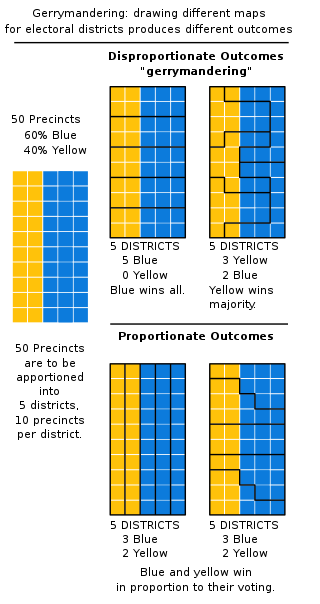
In representative democracies, gerrymandering is the political manipulation of electoral district boundaries with the intent to create undue advantage for a party, group, or socioeconomic class within the constituency. The manipulation may involve "cracking" or "packing". Gerrymandering can also be used to protect incumbents. Wayne Dawkins, a professor at Morgan State University, describes it as politicians picking their voters instead of voters picking their politicians.

The Philadelphia City Council, the legislative body of Philadelphia, Pennsylvania, consists of ten members elected by district and seven members elected at-large. The council president is elected by the members from among their number. Each member's term is four years, and there are no limits on the number of terms a member may serve.

The Wisconsin State Assembly is the lower house of the Wisconsin Legislature. Together with the smaller Wisconsin Senate, the two constitute the legislative branch of the U.S. state of Wisconsin.
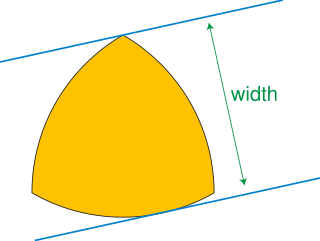
In geometry, a curve of constant width is a simple closed curve in the plane whose width is the same in all directions. The shape bounded by a curve of constant width is a body of constant width or an orbiform, the name given to these shapes by Leonhard Euler. Standard examples are the circle and the Reuleaux triangle. These curves can also be constructed using circular arcs centered at crossings of an arrangement of lines, as the involutes of certain curves, or by intersecting circles centered on a partial curve.
Political polarization is the divergence of political attitudes away from the center, towards ideological extremes.
An electoral district, also known as an election district, legislative district, voting district, constituency, riding, ward, division, electorate, or (election) precinct, is a subdivision of a larger state created to provide its population with representation in the larger state's legislative body. That body, or the state's constitution or a body established for that purpose, determines each district's boundaries and whether each will be represented by a single member or multiple members. Generally, only voters (constituents) who reside within the district are permitted to vote in an election held there. District representatives may be elected by a first-past-the-post system, a proportional representative system, or another voting method. They may be selected by a direct election under universal suffrage, an indirect election, or another form of suffrage.

The 1966 United States House of Representatives elections was an election for the United States House of Representatives on November 8, 1966, to elect members to serve in the 90th United States Congress. They occurred in the middle of President Lyndon B. Johnson's second term. As the Vietnam War continued to escalate and race riots exploded in cities across the country, Johnson's popularity had fallen, and the opposition Republican Party was able to gain a net of 47 seats from Johnson's Democratic Party, which nonetheless maintained a clear majority in the House. This was also the first election that occurred after the Voting Rights Act of 1965 became law, and the first time since 1870 that a Republican won a House seat in Arkansas, and the first since 1876 that they did so in South Carolina.
Congressional districts, also known as electoral districts in other nations, are divisions of a larger administrative region that represent the population of a region in the larger congressional body. Countries with congressional districts include the United States, the Philippines, and Japan.

Shaw v. Reno, 509 U.S. 630 (1993), was a landmark United States Supreme Court case in the area of redistricting and racial gerrymandering. After the 1990 census, North Carolina qualified to have a 12th district and drew it in a distinct snake-like manner in order to create a "majority-minority" Black district. From there, Ruth O. Shaw sued to challenge this proposed plan with the argument that this 12th district was unconstitutional and violated the Fourteenth Amendment under the clause of equal protection. In contrast, Reno, the Attorney General, argued that the district would allow for minority groups to have a voice in elections. In the decision, the court ruled in a 5–4 majority that redistricting based on race must be held to a standard of strict scrutiny under the equal protection clause and on the basis that it violated the Fourteenth Amendment because it was drawn solely based on race.
Compactness measure is a numerical quantity representing the degree to which a shape is compact. The circle and the sphere are the most compact planar and solid shapes, respectively.
Vieth v. Jubelirer, 541 U.S. 267 (2004), was a United States Supreme Court ruling that was significant in the area of partisan redistricting and political gerrymandering. The court, in a plurality opinion by Justice Antonin Scalia and joined by Chief Justice William Rehnquist and Justices Sandra Day O'Connor and Clarence Thomas, with Justice Anthony Kennedy concurring in the judgment, upheld the ruling of the District Court in favor of the appellees that the alleged political gerrymandering was not unconstitutional. Subsequent to the ruling, partisan bias in redistricting increased dramatically in the 2010 redistricting round.
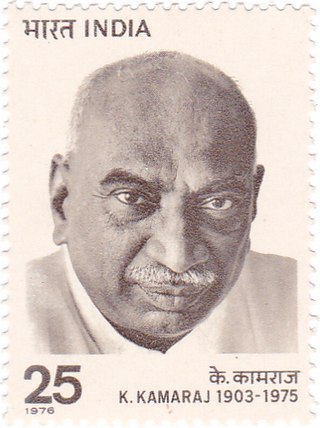
The second legislative assembly election to the Madras state was held on 31 March 1957. This was the first election held after the linguistic reorganisation of Madras State in 1956. Indian National Congress and its leader, K. Kamaraj won the election and defeated their rival, Dravida Munnetra Kazhagam. In 1954, due to the resignation of C. Rajagopalachari, for his controversial Kula Kalvi Thittam, the leadership of Congress was contested between K. Kamaraj, and C. Subramaniam. Eventually, K. Kamaraj, won the support of the party, was elected leader and chief minister of Madras State in 1954. In a surprise move, he appointed both M. Bhaktavatsalam and C. Subramaniam, to his cabinet, allowing great unity amongst the Congress that ruled the state of Madras, for the next decade. This election saw future DMK leaders M. Karunanidhi and K. Anbazhagan win their first MLA seats in the legislative assembly.
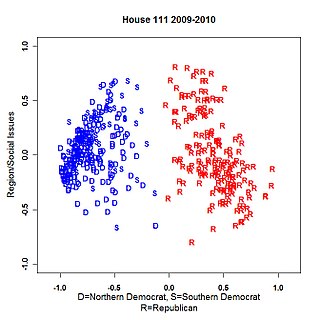
NOMINATE is a multidimensional scaling application developed by US political scientists Keith T. Poole and Howard Rosenthal in the early 1980s to analyze preferential and choice data, such as legislative roll-call voting behavior. In its most well-known application, members of the US Congress are placed on a two-dimensional map, with politicians who are ideologically similar being close together. One of these two dimensions corresponds to the familiar left–right political spectrum.
Daniel D. Polsby is former dean of the law school and professor of law at Antonin Scalia Law School and was previously Kirkland and Ellis Professor of Law at Northwestern University. He retired from George Mason University in 2021.

In the mathematical theory of minimal surfaces, the double bubble theorem states that the shape that encloses and separates two given volumes and has the minimum possible surface area is a standard double bubble: three spherical surfaces meeting at angles of 120° on a common circle. The double bubble theorem was formulated and thought to be true in the 19th century, and became a "serious focus of research" by 1989, but was not proven until 2002.
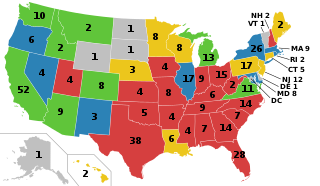
Gerrymandering is the practice of setting boundaries of electoral districts to favor specific political interests within legislative bodies, often resulting in districts with convoluted, winding boundaries rather than compact areas. The term "gerrymandering" was coined after a review of Massachusetts's redistricting maps of 1812 set by Governor Elbridge Gerry noted that one of the districts looked like a mythical salamander.
The efficiency gap is a measure to determine the fairness of electoral districts for first-past-the-post voting with a two-party system. It measures which political party had the most wasted votes. It has notably been used to inform debates around gerrymandering in the United States.
The Polsby–Popper test is a mathematical compactness measure of a shape developed to quantify the degree of gerrymandering of political districts. The method was developed by lawyers Daniel D. Polsby and Robert Popper, though it had earlier been introduced in the field of paleontology by E.P. Cox. The formula for calculating a district's Polsby–Popper score is , where is the district, is the perimeter of the district, and is the area of the district. A district's Polsby–Popper score will always fall within the interval of , with a score of indicating complete lack of compactness and a score of indicating maximal compactness. Compared to other measures that use dispersion to measure gerrymandering, the Polsby–Popper test is very sensitive to both physical geography and map resolution. The method was chosen by Arizona's redistricting commission in 2000.
Gaffney v. Cummings, 412 U.S. 735 (1973), is a Supreme Court decision upholding statewide legislative apportionment plans for Connecticut. The Court admitted that these plans entailed "substantial inequalities in the population of the representative districts." It observed that "the States have made virtually no attempt to justify their failure 'to construct districts ... as nearly of equal population as is practicable." It was a Fourteenth Amendment case. At issue was whether the election districts had been gerrymandered in violation of the Fourteenth Amendment to the Constitution.
Smiley v. Holm, 285 U.S. 355 (1932), was a decision of the Supreme Court of the United States involving a governor's power to veto a congressional redistricting proposal passed by a state's legislature. In an opinion by Chief Justice Charles Evans Hughes, the Court unanimously held that the U.S. Constitution did not prohibit Minnesota's governor from vetoing that state's redistricting map.
References
- ↑ Reock, Ernest (1961). "A Note: Measuring Compactness as a Requirement of Legislative Apportionment". Midwest Journal of Political Science. 5 (1): 70–74. doi:10.2307/2109043. JSTOR 2109043.
- ↑ Polsby, Daniel; Popper, Robert (1991). "The Third Criterion: Compactness as a Procedural Safeguard Against Partisan Gerrymandering" (PDF). Yale Law & Policy Review. 9: 301–353. doi:10.2139/ssrn.2936284. S2CID 46229993. Archived from the original (PDF) on 2019-07-02.
- ↑ Young, H. Peyton (1988). "Measuring the Compactness of Legislative Districts". Legislative Studies Quarterly. 13 (1): 105–115. doi:10.2307/439947. JSTOR 439947.